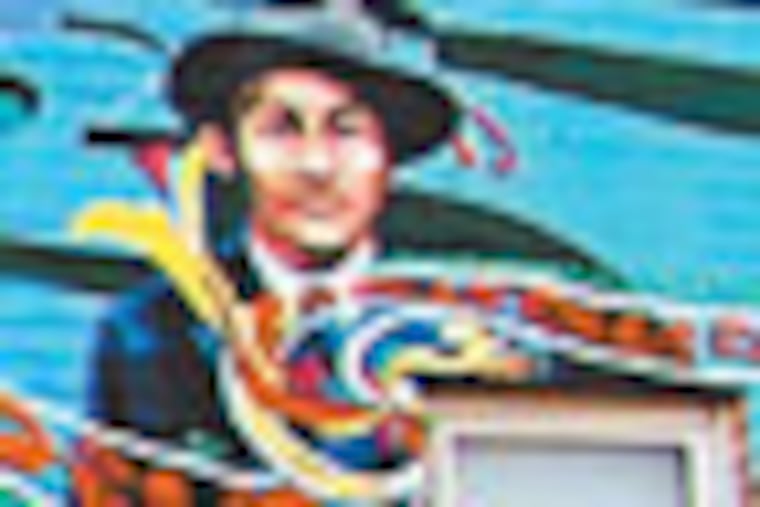Artist to complete mural honoring Philadelphia's Filipino population
They were barely noticed amid the boom of European immigration to Philadelphia in 1912. The 50 or so Filipino seamen, veterans of the U.S. Navy, remembered the city so fondly from their shore leaves they put down roots here.

They were barely noticed amid the boom of European immigration to Philadelphia in 1912.
The 50 or so Filipino seamen, veterans of the U.S. Navy, remembered the city so fondly from their shore leaves they put down roots here.
Once settled, though, they were met with discrimination. To protect themselves and preserve their Pacific island heritage, they formed the Filipino-American Association of Philadelphia.
A century later, more than 20,000 Filipinos live in Southeastern Pennsylvania and South Jersey, primarily Northeast Philadelphia and Cherry Hill. Theirs is still a relatively small immigrant community, but it is fast-growing and on the verge of new visibility - both on the printed page and the city streetscape.
Much of the interest is being stirred by one man, muralist Eliseo Silva, who lived in Philadelphia for a decade and was active in the Filipino community. He has compiled a book of vintage photographs, Filipinos of Greater Philadelphia, documenting their local history back into the 1920s.
Later this month - coinciding with the Filipino association's Sept. 15 centennial gala - he will complete a towering tribute mural on a commercial building at Bustleton Avenue near Tustin Street.
"There is no such thing as a history machine that will spew out all this history for you," he said. "We have to do it ourselves."
The trove of 200 photos is the latest addition to Arcadia Publishing's Images of America series. It draws in large part from the private collection of Patricia Carino Pasick, whose late Filipino father, Theodore Roosevelt Carino, spent his youth here.
The pictures show local Filipinos on rowhouse steps, or decked out for Rizal Day - the national holiday named for novelist Jose Rizal, executed in 1896 for inciting revolution against Spain.
An undated photo taken at the Philadelphia Navy Yard shows a Filipino-immigrant baseball team. In another, shot at a home, diners feast on tuyo, a traditional delicacy of smoked fish and vinegar.
Born in the Philippines, Silva, 40, earned a master's degree in fine arts from the Maryland Institute College of Art. He moved to Philadelphia in 2003, and to Los Angeles last year.
When he returns here this month, he will set to work finishing the 22-by-65-foot mural, titled My Heart's Sole Burning Fire. He already has filled in images of the three Filipinas he calls "the mothers of history": former Philippines president Corazon Aquino; Clemencia Lopez, a campaigner for Philippines independence; and Josefa Llanes Escoda, imprisoned and presumed executed in the Japanese occupation.
Aquino, who toppled Philippines dictator Ferdinand Marcos in the "people power" revolution of 1986, spent two years at Ravenhill Academy of Philadelphia, a parochial high school, Silva said.
Posted like sentries at the sides of the mural are the images of martyr Rizal and Carlos Bulosan, the Philippines-born author of America Is In the Heart, who spent most of his life in the United States.
Begun with private donations from local Filipinos, the mural is to be completed with additional money from the Philadelphia Mural Arts Program. When Silva lived in the city, he worked there.
"It's been his dream to do this project," said Mural Arts founder Jane Golden, but its impact is beyond personal.
"As Philadelphia becomes a more diverse city," she said, "it is important to give people the dignity and respect they deserve. Public art is a way to do that. The work is big and bold and in a public space."
The Philippines - 7,100 Pacific islands spread over an area the size of Arizona, with a population of 104 million - was a 16th-century Spanish colony ceded to the United States in 1898 after the Spanish-American War. In 1935, the islands became a self-governing commonwealth of the United States; they adopted English as a second official language, along with dialects of Tagalog.
In 1942, they fell under Japanese occupation. World War II ended that.
In 1946, the Philippines attained full independence.
"With all that history of colonial oppression," Silva said, "we are just beginning to tell our story, to define who we are."
Filipinos are the third-largest Asian group in America, outnumbered only by Chinese and Indians. In the 2010 census, 2.6 million people identified as purely Filipino - a 39 percent increase since the 2000 count. In Philadelphia, they rank fifth among Asian groups, behind Indians, Chinese, Koreans, and Vietnamese.
Psychiatrist Rommel Rivera of Media, president of the Filipino-American Association of Philadelphia, said Filipino immigrants arrive in the United States with the advantage of English fluency and have excelled as nurses, doctors, and IT specialists.
Among the traditions that his group promotes, he said, is a reverence for Mother's Day, with the selection of a local "mother of the year."
"The Philippines is primarily a matriarchal society," he said. "Mothers are the big boss."
Another tradition is the national dance called tinikling, a kind of hopscotching between parallel rods of bamboo clapped together at ankle height. Taught to young children, the dance simulates a farmer catching a bird in a bamboo trap, Rivera said.
Yet another is the annual pageant to select "Miss Maria Clara," an idealized Filipina named for the fictional heroine in a Rizal book.
Madeline Sapiandante, 21, of Glassboro, a William Patterson University senior, was last year's choice.
As the first generation of her family born in the United States, she said, "we get soaked up in the American culture and kind of lose a bit of our own."
Participating in the Filipino association, she said, "helps me be in touch with my heritage."